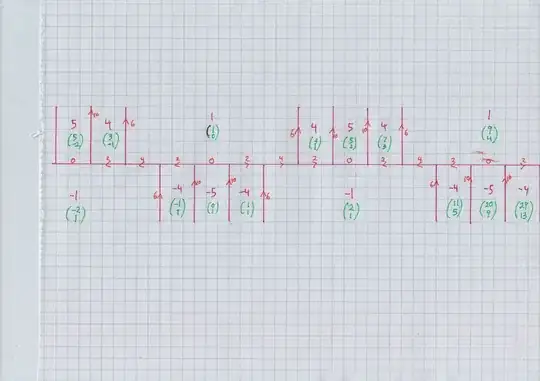$$ A =
\left( \begin{array}{cc}
9 & 20 \\
4 & 9
\end{array}
\right) ,
$$ and
$$ A^{-1} =
\left( \begin{array}{cc}
9 & -20 \\
-4 & 9
\end{array}
\right).
$$
$$
\left( \begin{array}{cc}
9 & 20 \\
4 & 9
\end{array}
\right)
\left( \begin{array}{c}
1 \\
1
\end{array}
\right) =
\left( \begin{array}{c}
29 \\
13
\end{array}
\right),
$$
$$
\left( \begin{array}{cc}
9 & 20 \\
4 & 9
\end{array}
\right)
\left( \begin{array}{c}
29 \\
13
\end{array}
\right) =
\left( \begin{array}{c}
521 \\
233
\end{array}
\right),
$$
$$
\left( \begin{array}{cc}
9 & 20 \\
4 & 9
\end{array}
\right)
\left( \begin{array}{c}
521 \\
233
\end{array}
\right) =
\left( \begin{array}{c}
9349 \\
4181
\end{array}
\right),
$$
Switching to $-A^{-1},$ we get
$$
\left( \begin{array}{cc}
-9 & 20 \\
4 & -9
\end{array}
\right)
\left( \begin{array}{c}
1 \\
1
\end{array}
\right) =
\left( \begin{array}{c}
11 \\
-5
\end{array}
\right),
$$
$$
\left( \begin{array}{cc}
-9 & 20 \\
4 & -9
\end{array}
\right)
\left( \begin{array}{c}
11 \\
-5
\end{array}
\right) =
\left( \begin{array}{c}
-199 \\
89
\end{array}
\right),
$$
$$
\left( \begin{array}{cc}
-9 & 20 \\
4 & -9
\end{array}
\right)
\left( \begin{array}{c}
-199 \\
89
\end{array}
\right) =
\left( \begin{array}{c}
3571 \\
-1597
\end{array}
\right),
$$
If you want to allow common factors,
$$
\left( \begin{array}{cc}
9 & 20 \\
4 & 9
\end{array}
\right)
\left( \begin{array}{c}
4 \\
2
\end{array}
\right) =
\left( \begin{array}{c}
76 \\
34
\end{array}
\right),
$$
$$
\left( \begin{array}{cc}
9 & 20 \\
4 & 9
\end{array}
\right)
\left( \begin{array}{c}
76 \\
34
\end{array}
\right) =
\left( \begin{array}{c}
1364 \\
610
\end{array}
\right),
$$
$$
\left( \begin{array}{cc}
9 & 20 \\
4 & 9
\end{array}
\right)
\left( \begin{array}{c}
1364 \\
610
\end{array}
\right) =
\left( \begin{array}{c}
24476 \\
10946
\end{array}
\right).
$$
Switching to $-A^{-1},$ we get
$$
\left( \begin{array}{cc}
-9 & 20 \\
4 & -9
\end{array}
\right)
\left( \begin{array}{c}
4 \\
2
\end{array}
\right) =
\left( \begin{array}{c}
4 \\
-2
\end{array}
\right),
$$
$$
\left( \begin{array}{cc}
-9 & 20 \\
4 & -9
\end{array}
\right)
\left( \begin{array}{c}
4 \\
-2
\end{array}
\right) =
\left( \begin{array}{c}
-76 \\
34
\end{array}
\right),
$$
$$
\left( \begin{array}{cc}
-9 & 20 \\
4 & -9
\end{array}
\right)
\left( \begin{array}{c}
-76 \\
34
\end{array}
\right) =
\left( \begin{array}{c}
1364 \\
-610
\end{array}
\right),
$$
so you see nothing new happens this time.
